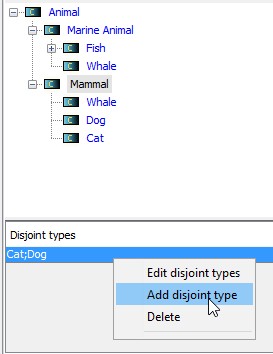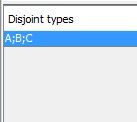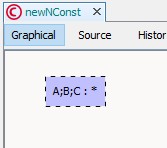Forbidden types
In a graph, the concept vertices may be associated to a conjunctive types, meaning it has several types. As a result, the model provides a mechanism to prohibit some incongruous associations. For instance, suppose you have defined both "Animal" and "Plant" concept types, you might want to prohibit associations between these types as well as between sub-types of them. It is possible to express this restriction in your concept type hierarchy. To this end, you are going to introduce a forbidden type in the concept type View to express this incompatibility. See below an example of such restriction expressed in the concept type hierarchy triggers and here it triggers an error in a conceptual graph.
Forbidden types (also named disjoint types) can be added in the view placed below the concept type tree:

It is possible to create sets of 3 conjunctive types or more. If the forbidden type (A;B;C) is defined, all subset will be forbidden (A;B) (B;C) (A;C) and of course (A;B;C). This corresponds to the most frequent needs of the users. If you want to specify that only the conjunction (A;B;C) is forbidden a negative constraint can be used.
|
|
All subsets of A,B,C with card>1 is forbidden |
Negative constraint for A;B;C |
Created with the Personal Edition of HelpNDoc: Easily create EBooks

